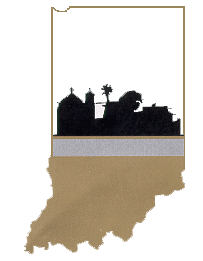 |
Indiana
Farmstead Assessment for Drinking Water Protection
Livestock Waste Storage
|
 |
Use this survey to assess the risk to water quality posed by
your livestock waste storage. Circle the answer that best describes your situation.
At the end of each section sum the numbers that correspond to each answer
for the section. When you have completed the survey sum the section totals
for the risk assessment score. Refer to Fact Sheet 7 for more information
on livestock waste storage.
For each question, a (1) represents a higher risk to drinking
water than a (3).
Location
of Manure Storage
1. Is the manure storage structure more than 100 feet from:
water wells? Yes (3) No (1)
surface waters? Yes (3) No (1)
field tiles? Yes (3) No (1)
2. Is the manure storage structure downslope from:
water wells? Yes (3) No (1)
surface waters? Yes (3) No (1)
3. What is the soil texture at the site of your manure storage structure?
clay (3)
loam (2)
sand (1)
4. Is the water table or fractured bedrock layer more than 20 feet
below the bottom of the manure storage structure?
Yes (3)
No (2)
5. Is the seasonal high water table ever within 3 feet of the bottom
of the manure storage structure?
Yes (2)
No (3)
Location section total __________
Storage
Structure
Storage Type For this section, answer only the questions for the type
of manure that you store: liquid/semi-solid or solid.
* If you use a water tight structure to store solid manure,
answer Question 6.
Liquid or Semi-solid Manure Steel and concrete structures
6. Does the storage structure have any noticeable leaks?
Yes (3)
No (9)
Earthen storage pits and lagoons 7.
Is the pit or lagoon lined with clay or plastic?
Yes (3)
No (1)
8. When pumping out the waste, have you seen any cracks in the soil
or tears in the lining of the pit/lagoon?
Yes (2)
No (1)
Solid Manure Storage
9. What type of surface is your manure stacked on?
concrete (3)
earthen (2)
10. Is the manure stack exposed to rainfall or surface water runoff?
Yes (1)
No (3)
11. Does the yard have a settling basin and/or grass infiltration
strip to receive runoff?
Yes (3)
No (1)
Storage Type section total __________
Design
and Maintenance
12. Was your manure storage structure designed and installed according
to accepted engineering standards and specifications?
Yes (3)
No (2)
13. Do you perform regular inspection and maintenance procedures on
the manure storage structure (e.g., clean outlets and check for
seepage, erosion, weakened berms, and burrowing animals)?
Yes (3)
No (2)
14. Is all roof water and clean surface runoff diverted away from the
manure storage structure?
Yes (3)
No (2)
15. Have you ever had a leak or break in your manure storage structure
that resulted in manure (solid or liquid) being released to the
environment, either underground or aboveground?
Yes (1)
No (3)
Design and Maintenance section total __________
Risk
Assessment for Livestock Waste Storage
Add the following totals:
Location section total ____ x 3 = _____
Storage Type section total ____ x 2 = _____
Design and Maintenance section total = _____
Survey 7 Score ____________
----------------------------------------------------------------------
Low Moderate High
102 - 75 74 - 60 59 - 34
----------------------------------------------------------------------
To see Fact sheet 7 click here.
Livestock Waste Storage
Fact Sheet
| Reviewed 5/1/01 |
|
It is the policy of the Purdue University Cooperative Extension Service,
David C. Petritz, Director, that all persons shall have equal opportunity
and access to its programs and facilities without regard to race, color,
sex, religion, national origin, marital status, parental status, sexual
orientation, or disability. Purdue University is an Affirmative Action
employer. This material may be available in alternative formats. 1-888-EXT-INFO.
|

